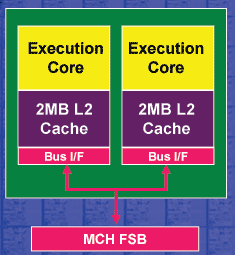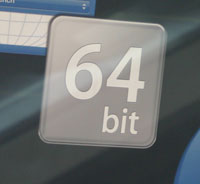Apple's Move to x86: More Questions Answered
by Anand Lal Shimpi on June 7, 2005 4:55 AM EST- Posted in
- Trade Shows
So, which Intel CPUs will Apple be using?
Steve Jobs stated that they'd be shipping Intel based Macs by June 2006, so let's consult the handy Intel roadmaps and see what will be available by June 2006.
On the desktop side, two new 65nm cores will be introduced in Q1 2006 - well before Apple's June 2006 deadline: the dual core Presler and the single core Cedar Mill processors.
We saw Presler running at last year's Fall IDF, albeit only at 2.0GHz. When Presler makes its debut early next year, it will be clocked at 2.8GHz at the low end and 3.4 - 3.6GHz at the high end. The chip will also feature a 2MB L2 cache per core and we're guessing that a number of architectural enhancements didn't make their way into Prescott. As is the case with the current Pentium D, Presler will not have Hyper Threading enabled by default, although the Extreme Edition based on Presler may have HT enabled.

Intel's Presler, most likely the first high end Powermac candidate for Apple next year.

With Intel's dual core processors, Apple can effectively offer the same TLP as their current dual processor G5s with only a single CPU socket in next year's Intel solutions. If you've ever looked at the cooling solutions required for Apple's 2.5GHz or 2.7GHz G5 systems, being able to cut that down by a half would definitely help lighten up and reduce the cost of producing/shipping their machines. One advantage that the G5 does currently have is that its die is extremely small, measuring only 66 mm2 compared to the 206 mm2 Pentium D die. The move to 65nm will help Intel, but the G5 definitely has a size advantage. However, with Intel's volumes, it is unlikely that the die size advantage will translate into any pricing advantage for the PowerPC chips over Intel's solutions for Apple.
The most excitement appears to be around Apple's ability to get their hands on the Pentium M next year - not to mention that in Q1 2006, Intel will begin shipping Yonah, their first dual core Pentium M processor. In our review of the PowerBook G4, we talked about the bulk of the unit and how it would be nice to get something smaller. Well, with the Pentium M, Apple will be able to produce a truly thin and truly light PowerBook without sacrificing performance.
But, let's not get caught up in the next year alone. Clearly, Apple is interested in the long haul, as you don't make this sort of a commitment without looking at the 5-, 10- and 15-year futures for your partner. Presler and Cedar Mill weren't the cores that won Apple over; it is Intel's Platform 2015 vision, the NetBurst successor and their ability to learn from their mistakes with the Pentium 4 that are what won Apple over. As many of you have pointed out, Apple may very well just skip over the NetBurst generation of desktop processors and initially begin the switch to Yonah on the mobile side - arguably where Apple needs a refresh the most. Then, in line with Intel's roadmap, introduce Intel's replacement architecture for NetBurst later in 2006 or by the middle of 2007.
Why not AMD? Much of Apple's success is due to marketing and branding, not necessarily technological leadership. That should sound a lot like Intel these days, whose processors essentially lag behind AMD in terms of technology, but outsell AMD by huge margins, thanks to strong marketing and branding. The Intel brand is much stronger than AMD's, and that is the sort of partner that Apple is interested in.
The ability to supply Apple's volumes isn't a huge deal, as many have pointed out. AMD could most definitely handle Apple's volumes. Intel's pricing to Apple is most likely far more attractive than anything AMD could put together, however, and when existing as a premium PC manufacturer is already quite difficult, any breaks on CPU pricing that you can get are definitely worth it.
So, why not support both AMD and Intel? Apple may in the future, although it is highly unlikely anytime soon - especially given whatever sort of pricing arrangement that Apple and Intel have worked out. Right now, Apple has no intentions of confusing their marketplace. Let the transition from PPC to x86 take place, and then worry about Apple supporting AMD. If Intel does indeed embrace an on-die memory controller and a Hyper Transport-like interface by 2007 in a cooler running architecture, the demand for Apple to support AMD may in fact diminish.
Intel needs a partner like Apple. For the longest time, Intel has been promising usage models and concept PCs that we all wanted, but would never surface. PC vendors focused on producing the cheapest system possible, while dealing with backwards compatibility and standards compliance with a huge install base - effectively, making change difficult. Look at how long it has taken us to transition away from the Parallel and Serial ports on PC motherboards or the move to SATA drives. With Apple, Intel finally has a partner that is willing to adapt to change at a much more rapid pace and one that can implement new technologies extremely quickly, thanks to a small, agile user base.
The Apple/Intel relationship will definitely change the dynamics of many business relationships spanning the entire PC industry. The question is no longer "if...", but rather "how...".










56 Comments
View All Comments
Jeff7181 - Tuesday, June 7, 2005 - link
I never thought about how it would benefit Intel in that they keep coming up with these standards for PC's that are never really adopted by OEM's... maybe Apple will help with this.Also something I haven't seen anyone mentioned is Dell. If Apple's Intel powered computers are simiarly priced to a Dell, I think Dell stands to lose marketshare. People who own a Dell and don't like Microsoft for whatever reason could possibly have a viable alternative in a Mac.
Zebo - Tuesday, June 7, 2005 - link
If AMD collapses, Intel would immedately go back to it's good old days of 1990-1998 of $500 CPUs.Anyway Stevie will bankrupt Apple like he did with NeXT. The only thing which has saved Apple is iPod which is now dying now that people have baught a clue how overpriced and underfeatured it is. Apples's PC sales conitinued to diminish under Jobs leadership so he had no choice but to go x86. But this is the nail in Apples coffin. $400 Dells' will kill them.
Ged - Tuesday, June 7, 2005 - link
I'm dissapointed.I am also puzzled as to how Apple can show how much better the PowerPC CPUs are on their website than Intel's and AMD's CPUs and then switch to Intel in two years time while pointing to Performance vs. Power.
Anand's comments about the Apple user base supporting anything that Jobs does must really be true (not that I was doubting you Anand, it's just hard for me to stomach seeing how Apple has made every attempt to show PowerPC superiority to the x86 platforms and now this).
plewis00 - Tuesday, June 7, 2005 - link
Given the interest OS X on x86 has sparked I would almost guarantee someone will be cracking it in the immediate, popular software is always the first to be cracked and I'd say this will be high on their priorities... and given that, Apple really is shooting themselves in the foot by missing out on that market it could easily tap into and make a lot of money on.zzmad - Tuesday, June 7, 2005 - link
I just think the roadmap thing in the article is wrong.Apple will move first the notebboks, Mac minis and eventually new products based on Centrino leaving (FINALLY) Freescale. That's the real market, growing 3 times as fast as the desktop.
As for the desktop Apple has in the pipeline (September or Jan 2006) the Dual core 970MP with 1MB cahce at 3.0Ghz, full 64bits, altivec. Those CPU's will find their way into the Powermacs giving a real strong performance machine. Also another CPU the 970GX will probably find its way into the iMac G5. Until 2007 we won't see any powermac with intel.
It's interesting to understand what processor will be used then. I think something like a dual Xeon, 64, dual core. And something also for the Xserve. I bet Jobs would love to renew Pixar render farm and worstations using Intel Macs!
bobsmith1492 - Tuesday, June 7, 2005 - link
What? No comments?I can't resist. :P
Anyway, this is interesting I suppose. I still don't see much use for these things.